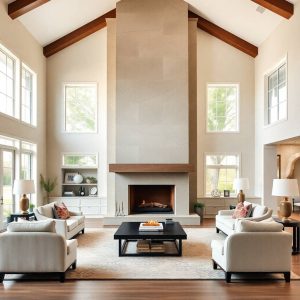
Living space (also called livable square footage, finished square footage, or heated area) refers to the parts of the home that are finished, climate-controlled, and intended for everyday use. It does not include unfinished basements, garages, attics, or exterior areas.
In insurance, living space is one of the primary factors used to calculate your dwelling coverage and policy cost because it drives the cost to rebuild the home if it is destroyed.
1. What Counts as Living Space
To be counted as living space, an area must be:
| Requirement | Meaning |
|---|---|
| Finished | Flooring, walls, ceilings completed (not exposed studs or concrete) |
| Heated / Cooled | Connected to central HVAC or other permanent heat source |
| Accessible | Reachable from the main interior (not via exterior-only entry) |
| Legal to Occupy | Meets building code (ceiling height, egress windows, electrical, etc.) |
Examples of Living Space
- Bedrooms
- Bathrooms
- Kitchen and dining areas
- Living and family rooms
- Finished basement with HVAC
- Finished attic with proper ceiling height
- Hallways and internal closets
What Does Not Count as Living Space
These areas do not add to insurance living square footage:
| Not Living Space | Why Not Included |
|---|---|
| Unfinished basement | No finished walls/floors or climate control |
| Garage (attached or detached) | Not living area; different risk category |
| Attic without permanent stairs & climate control | Not legally habitable space |
| Screened porch or deck | Exterior / not climate controlled |
| Shed / non-permitted additions | Not insurable as dwelling space |
These spaces may be covered, but they do not drive the replacement value the same way living space does.
2. Why Living Space Matters to Insurance
Insurance companies price policies based on how much it would cost to rebuild your home, not its market value.
More Living Space = Higher Rebuild Cost
More square footage means more:
- Framing materials
- Drywall
- Electrical wiring
- Plumbing runs
- Flooring
- Paint / trim
- Labor hours
So, larger living area = higher Coverage A = higher premium.
3. How Insurers Use Living Space in Cost Calculations
Insurers run your home data through a Replacement Cost Estimator (RCE).
The RCE uses:
- Living square footage
- Number of stories
- Roof complexity
- Foundation type
- Interior finish level (basic vs premium)
Then it produces the cost per square foot to rebuild × total living area = Coverage A (Dwelling Limit).
Example:
- 2,000 sq. ft living area × $200 per sq. ft construction cost
= $400,000 dwelling coverage
If you increase finished living space (e.g., finish a basement):
- Your Coverage A and premium will increase.
4. How Miscounted Living Space Impacts You
| Situation | Result |
|---|---|
| Living space is underreported | Policy could be undervalued → not enough money to rebuild after a disaster |
| Living space is overreported | You overpay for insurance unnecessarily |
This is why insurers often use:
- MLS records
- County property data
- Appraisals
- Satellite home measurement tools
And why you should correct errors if found.
5. Key Point
Insurance does not care how much your house is worth to sell — only how much it costs to rebuild.
Living space determines that rebuild cost more than anything else.
Summary
| Concept | Explanation | Effect on Insurance |
|---|---|---|
| Living Space | Finished, climate-controlled, habitable interior area | Used to calculate rebuild cost |
| Larger Living Area | Requires more materials & labor to rebuild | Higher premiums |
| Non-living Spaces | Garages, unfinished basements, attics, porches | Not counted toward square footage |
